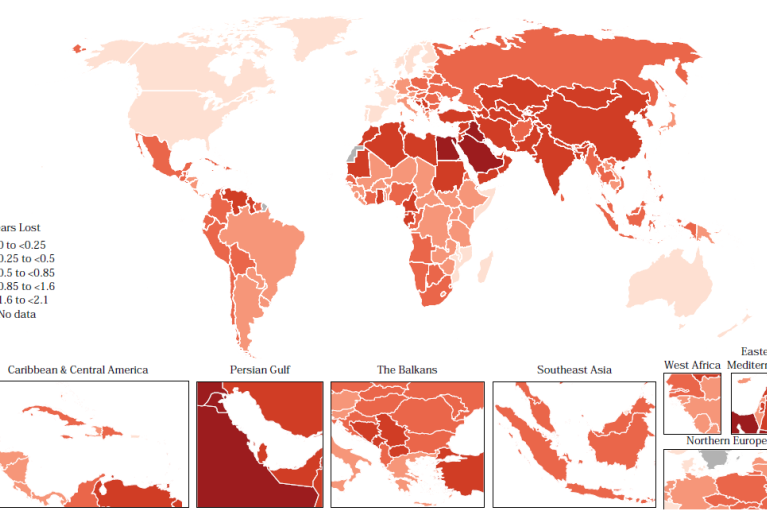SIGNIFICANT IMPACTS
Exposure to Air Pollution Reduces Life Expectancy.
Current levels of air pollution have reduced life expectancy by 1 year and 8 months on average worldwide.
- Considered separately, in 2019 ambient fine particulate matter (PM2.5) reduced life expectancy by 1 year, household air pollution by 0.7 year, and ambient ozone by 0.07 year.
- Air pollution reduces average life expectancy by almost as much as tobacco use.
Figure DD. Contribution of major risk factors and diseases to loss of life expectancy.
DISPARITIES ACROSS REGIONS
Less-developed countries have the most to gain in life expectancy.
- Air pollution’s impact on life expectancy is greatest in less-developed areas, where many people suffer a double burden from high ambient PM2.5 and exposure to household air pollution.
- Air pollution attributable life expectancy losses were greatest in Oceania, South Asia, and sub-Saharan Africa, where LE loss can be as high as 2 to 2.8 years for some countries.
- The countries with the greatest life expectancy losses linked to air pollution were Papua New Guinea (3.2 yr), Niger (3.1 yr), and Somalia (3.04 yr).
- The countries that currently suffer the highest PM2.5 exposures would have the most to gain from reducing air pollution.
Figure EE. Life expectancy loss attributable to levels of PM2.5 in 2019.
PROBING THE DATA
The team used a robust methodology to assess impacts on life expectancy.
Life expectancy is a statistical estimate of the average lifespan (that is, years from birth to death) that an individual in a population is expected to live. It considers all the factors that affect life expectancy in a population including age and sex, underlying health status, smoking, diet, and other risk factors like air pollution.
To estimate the impact of a particular factor on life expectancy, researchers quantify the likelihood of dying from diseases related to that factor at different ages in a population and calculate a “risk-deleted” life expectancy — that is, the length of life that would be expected if the factor were absent. The average difference between life expectancy with and without the risk factor quantifies the average change in life expectancy attributable to that factor. For details, please refer to the report.




